As part of our regular PCI® Practitioner training workshops attendees are encouraged to share their experiences of working with the methodology. 
Including getting input from our highly experienced Change facilitators on how to overcome any potential barriers, possible next steps and ways to accelerate Change progress.
So, are there any patterns in this process? We find there 6 key lessons that crop up time after time.
Lesson #1: Those that fail to learn from history, are doomed to repeat it
This is very true for major change projects. As one of the key determinants of your future success in change is having a clear understanding of where your organisation has already been in change terms.
As Change Practitioners there is a danger that we slip into well-worn patterns of implementation. Often using the same - limited number of questions and approaches that fit our comfort zone. 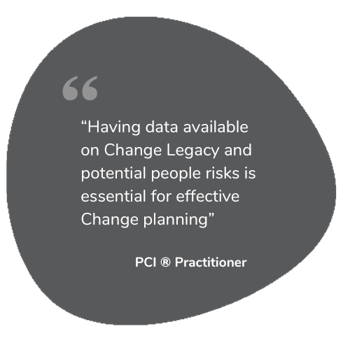
The key, however, as you plan for new change initiatives is to have one eye on the potential impact of your Change Legacy.
Most of our PCI® practitioners find that a key early step in any Change project is to analyse how previous changes were implemented and what worked. Or, just as importantly, didn’t work.

|
By using our Initiative Legacy Assessment tool, which is available via our digital platform, our Change Practitioners are able to adopt a data-driven approach to planning organisational change. To identify key potential areas of people-risks for the change early. And to shape the way the implementation needs to be architected to mitigate those risks. |
Lesson #2: When kick-starting a change, go for clarity
An obvious statement perhaps, but Change Practitioners tell us that building both urgency and momentum for change is not that easy.
Powerful Change Communications can help make people:
- dissatisfied with their current ways of working
- better understand the costs associated with not changing
- form a positive, clear and even attractive stance on the future state that the Change is trying to put in place
- see practical, manageable ways that the change will be achieved
 And there are many reasons why getting the balance in communications to achieve this can be difficult. It is often the imperative part of this statement that is paid insufficient attention. At least, in part, because managers often find the imperative difficult to deliver. They worry it will create uncertainty and negative feelings, which all flies in the face of established management thinking and training. Which advocates being positive, upbeat and focused on the future.
And there are many reasons why getting the balance in communications to achieve this can be difficult. It is often the imperative part of this statement that is paid insufficient attention. At least, in part, because managers often find the imperative difficult to deliver. They worry it will create uncertainty and negative feelings, which all flies in the face of established management thinking and training. Which advocates being positive, upbeat and focused on the future.
Of course, we can’t turn every Change into an ‘end of the world’ event. And too much imperative can create fear that is immobilising. But in today’s world where demand for Change is outstripping our capacity to deliver, it is better for people to be very clear about why Change is business critical for employees. And why it is important for them to get onboard. Rather than to be excited about vague, and somewhat inaccessible, future opportunities.
We need people to be realistic about their current state and yet willing to try out new things. And managers need to be able to balance these two messages so that people are ready to explore, and even play an active part, in defining the roadmap to get to the vision.
Lesson #3: The role of Change Agents and Sponsors are different
It is also sometimes the case that we see newly trained Change Agents who believe that, through their new-found skills and with a bit of courage, they can bypass Sponsors and drive change projects more or less on their own. And, from time to time they can pull this off, and indeed may even get change implemented. However, more often than not, they tell us that they can’t get their Change Sponsors to devote the requisite amount of time to a project. Or even that their Sponsor is not the best leader of Change.
What we tend to find here is that their inability to create a strong coalition of Sponsors – early in the project lifecycle - turns out to be their undoing.
Source: Changefirst
Change Practitioners need to take time early to engage Sponsor support. And, also, be very specific about what they need from Sponsors at different times in the project. In short, helping their Sponsors to better help them.
Lesson #4: Creating engagement is time consuming but worth every minute
Studies have connected high levels of employee engagement to better organisational performance. With highly engaged employees found to perform 20% better and be 87% less likely to leave an organisation.
However, on Change projects specifically, the ability to really engage people early in the lifecycle is critical. And this is not achieved solely with communication. For example, people are far more likely to adopt a process that they had a part in designing. Whether that is warehouse staff designing their own implementation programme, salespeople inputting to a CRM roll-out, cross-functional teams re-designing business processes or junior level executives analysing what is going wrong in specific parts of a business. Control matters to people. And besides, two heads, or more, are always better than one.
Our Change Practitioners consistently tell us that an investment in engagement creates far greater ownership and control during Change. And that, while creating effective engagement is a time-consuming business, it pales into insignificance to the time spent trying to implement Change with unengaged managers and employees.
The data below is from our Initiative Risk Assessment tool (one of 9 assessment tools in our Diagnostics Pro toolkit) and is based on responses from over 10,000 respondents across 111 organisations.
Source: Initiative Risk Assessment, Changefirst
The data highlights how engagement matters to people and where it is most lacking in their Change processes.
Lesson #5: It isn’t always about money, recognition matters too
Most Change Initiatives require extra effort from people and conventional wisdom would dictate that financial incentives are going to have the biggest bearing on Change success.
In fact, we find that many Change Agents starting out in the role assume they will need substantial bonuses or incentives to change people’s behaviour. However, it is often small, unexpected awards that can have a very positive effect. Some examples that we have seen succeed in the past include handwritten letters from the CEO, impromptu team celebrations, personalised gift tokens and thanks in public forums. Or even small gifts sent to spouses or partners to recognise that project team members had been working extra-long hours to push projects over the line.

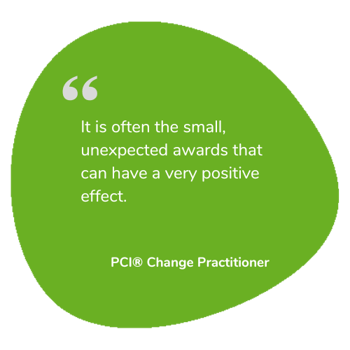
These items of recognition will often exceed people’s expectations, feel appropriate and seem personal to them. What our newly trained Change Agents find out here is that you can be very successful when you “pleasantly surprise people.”
Looking for more inspiration?
Take a look at Drive: The surprising truth about what motivates us by Dan Pink.
Lesson # 6: Middle managers are the key to Change success
Middle managers are often cited as one of the major barriers to successful Change. And, sometimes they are.
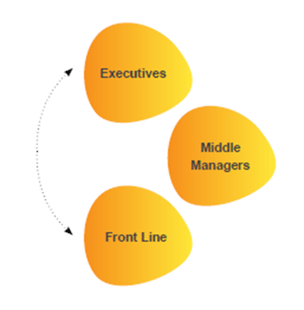 However, the problem is that, very often, they are also alienated from the Change process. Instead of trying to involve them to help get people on side with the Change. Or asking their opinion and getting key people in that group to help design the solution - or give feedback on implementation strategies – they are often by¬passed whilst major Change is announced to everyone at the same time.
However, the problem is that, very often, they are also alienated from the Change process. Instead of trying to involve them to help get people on side with the Change. Or asking their opinion and getting key people in that group to help design the solution - or give feedback on implementation strategies – they are often by¬passed whilst major Change is announced to everyone at the same time.
Source: PCI® Change Management Methodology
Many of the Change Agents who come to us for training learn that they need to find ways of treating these managers as people who can become convinced of the need for Change. Once that happens, they can then become a valuable resource to help Change Agents themselves – by playing a key role in convincing their own teams and people to Change. The key here is that Change Agents need to move managers from being impediments to Change - to accelerators of Change success.
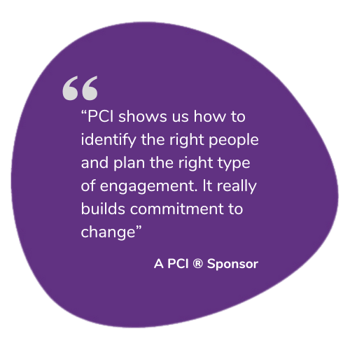
In our own PCI® methodology we dedicate one full Critical Success Factor – CSF4 Committed Local Sponsors – to empowering middle and front-line managers to become key players in effective change. By giving them the skills and tools to be effective local sponsors.
|
METHODOLOGY FOCUS PCI® can help your deliver effective Change CommunicationsDelivering effective organisational Change Communications can be challenging. Our PCI® Change Management methodology offers:
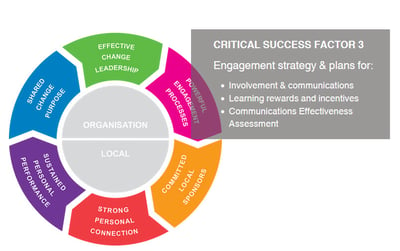
All as part of a wider approach to foster engagement that includes involvement, rewards and recognition. Plus structured learning about Change. Learn more here |

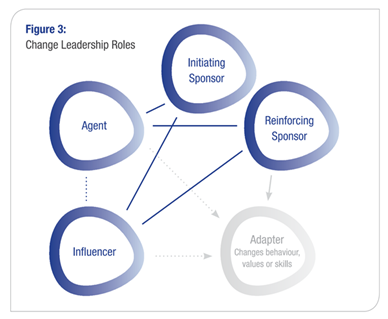



Leave a comment